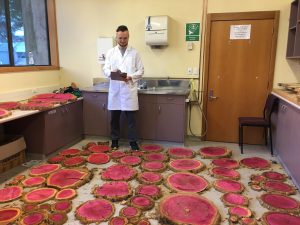Phone: 03 577 2395
C/- Marlborough Research Centre Trust, PO Box 875, Blenheim 7201


Only heartwood is naturally durable. As a tree grows, cells in the centre of its stem die after extractives are deposited to form heartwood. Extractives are the key to durability. The amount of these organic compounds varies between trees: trees with high extractive content have a good chance of being naturally durable.
Both the amount of extractives and the amount of heartwood in trees is highly variable. As only heartwood is durable, heartwood volume will ultimately determine the value of a stem.
We have developed novel techniques to extract cores from very young trees. A new coring tool was designed with the help of the Callaghan Innovation, and with this tool we have sampled and analysed thousands of cores from our breeding population. Extracted cores are taken back to the lab where we then measure the amount of extractives in each core using near-infrared spectroscopy. This means we can identify the trees with the highest levels of extractives at a young age. This will be an ongoing process as the various species within our breeding populations reach a large enough diameter for cores to be extracted.
Taking cores at a trial site - photo gallery
See the new corer in action - 30 second video
Read more about NIR imaging at the School of Forestry.
PhD student Daniel Boczniewicz worked on developing a stem taper model for Eucalyptus globoidea. His most recent fieldwork was in the Okuti Valley, Canterbury, where he worked in a 29-year old Eucalyptus globoidea stand.
Thirty one trees were harvested and their taper was analysed. In addition, 315 discs were collected. These were analysed to provide the taper data of heartwood. Finally, all the standing trees were GPS-located for future analysis of environmental effects on heartwood formation.
Daniel then developed an interactive heartwood taper and volume model for E. globoidea.
Further work developing the E. globoidea model, along with a similar E. bosistoana model, is being under taken by Prof. Euan Mason. A carbon sequestration component has been added to the E. globoidea model.
See our Measurement and Modelling section for more information.

PhD student Daniel Boczniewicz analyses heartwood in 29-year old E. globoidea

Discs created in the field.
Check out our Library for all wood technology publications.
Follow our Project Updates for regular news of wood quality research.
C/- Marlborough Research Centre Trust, PO Box 875, Blenheim 7201